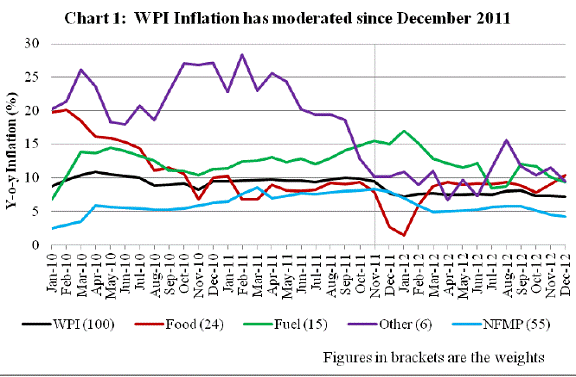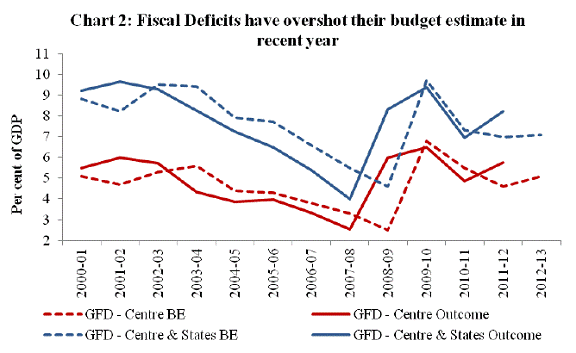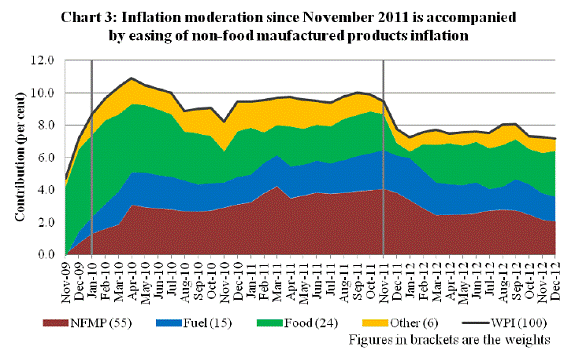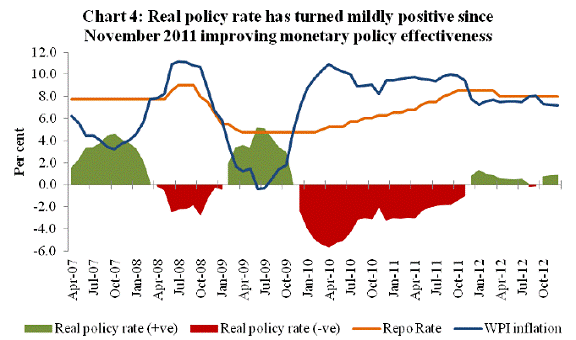 IST,
IST,


Indian Inflation Puzzle
Shri Deepak Mohanty, Executive Director, Reserve Bank of India
delivered-on ജനു 31, 2013
Respected dignitaries on the dais: Advocate V. R. Parnerkar, Advocate Laxmikant Parnerkar, Shri Pradip Palnitkar, Shri Mohan Tanksale, Justice Mhase, Dr. S. N. Pathan and Dr. Ashutosh Raravikar; Ladies and Gentlemen. It is indeed my honour that Late Dr. Ramchandra Parnerkar Outstanding Economics Award for 2013 has been bestowed upon me. I thank the Poornawad Charitable Trust and its Life Management Institute for this recognition. It is heartening to see that over the last so many years, the Trust has taken up the mission of people’s welfare and is working towards enrichment of our life through various social service activities, inspired by the life and mission of Dr. Parnerkar. Vidvat Ratna Dr. R. P. Parnerkar (1916-1980) was a great philosopher and thinker. He recognised that human beings require incentive for action. At the same time, they need emotional support to tie over adversities and sustain their effort. He was a Karma Yogi. He used to say, “Only singing the praise of the God without putting in efforts would not lead you anywhere. Master is like electricity and disciple is like a bulb. A bulb with broken filament cannot experience the illumination from electricity.” Dr. Parnerkar put forth his economic and philosophical thought, which he termed Poornawad. It says that matter and the mind are manifestations of only one and the same reality which he called Poorna. The economic doctrine revolves around the central idea of food as a fundamental human right. He believed that as long as a person has to earn his food at somebody else’s wishes, humanity would always remain in doldrums. He believed that free food will not make people indolent as multiple other needs would make him toil. The problems of food security, poverty and unemployment, which were close to his heart, are the burning issues even today. The Food Security Bill as introduced in the Parliament by the Government in a way comes close to that dream of Dr. Parnerkar. His economic insight blended with humanism will always remain a beacon for generations. I was wondering how best to honour Dr. Parnerkar’s contribution? Given his deep commitment to social welfare, I thought he would have been concerned as we have been in the Reserve Bank of India about the current state of inflation, particularly food inflation. We have been grappling with this for some time now. I take this opportunity to share my thoughts on the topic of inflation which affects one and all. Over the last three years the persistence of inflation in an environment of falling economic growth has come out as a “puzzle”. In my presentation I propose to address the following questions: What do I mean by a “puzzle”? Why do we need to worry about inflation? What is the nature of the current inflation process? How did monetary policy respond to the recent bout of inflation? I conclude with some thoughts on the way forward to achieve price stability. Current inflation Puzzle? First, let me begin by giving the context. India is a moderate inflation country. For example, in the 62 years since 1950-51average annual inflation rate as measured by changes in the wholesale price index (WPI) increased at a rate of 6.7 per cent per annum. That is not a very high rate considering that many countries, both developed and developing, experienced very high inflation in their modern development history. In fact, more recently in the 1980s and 1990s the world inflation averaged around 17 per cent per annum. In the 2000s there was a sharp all round moderation in global inflation. In the eight year period from 2000 to 2007, the world inflation averaged 3.9 per cent per annum. Even the emerging and developing economies (EDEs) which traditionally had very high inflation showed an average annual inflation at 6.7 per cent. India’s inflation performance was even better at 5.2 per cent as measured by WPI and 4.6 per cent measured by the consumer price index (CPI-IW). In 2008 the global financial crisis struck following which inflation rose sharply both in advanced countries and EDEs as commodity and oil prices rebounded ahead of a sharp “V” shaped recovery. Thereafter, inflation rate moderated both in advanced economies and EDEs. In India too the inflation rate rose from 4.7 per cent in 2007-08 to 8.1 per cent in 2008-09 and fell to 3.8 per cent in 2009-10 (Table 1). However, the inflation rate backed up and stayed near double digits during 2010-11 and 2011-12 before showing some moderation in 2012-13. Given India’s good track record of inflation management, the persistence of elevated inflation for over two years is apparently puzzling. Second, the deceleration of growth and emergence of a significant negative output gap has failed to contain inflation. It is understandable if inflation goes up in an environment of accelerating economic growth. There could be a situation when the real economy is growing above its potential growth that could trigger inflation what economists call an overheating situation. It is like an electric cable exploding if we overload it with appliances beyond its capacity. But, that is not the case. The Reserve Bank estimates suggest that the potential output growth of the Indian economy dropped from 8.5 per cent pre-crisis to 8.0 per cent post-crisis and it may have further fallen to around 7.0 per cent in the recent period. Even against this scaled down estimate of potential growth, actual year-on-year GDP growth has decelerated significantly from 9.2 per cent in the fourth quarter of 2010-11 to 5.3 per cent in the second quarter of 2012-13. The loss of growth momentum that started in 2011-12 got extended into 2012-13. During a boom, economic activity may for a time rise above this potential level and the output gap becomes positive. During economic slowdown, the economy drops below its potential level and the output gap is negative. Economic theory puts a lot of emphasis on understanding the relationship between output gap and inflation. A negative output gap implies a slack in the economy and hence a downward pressure on inflation. So, India’s current low growth-high inflation dynamics has been in contrast to this conventional economic theory. Real GDP growth has moderated significantly below its potential. Yet inflation did not cool off. Third, the Reserve Bank raised its policy repo rate 13 times between March 2010 and October 2011 by a cumulative 375 basis points. The policy repo rate increased from a low of 4.75 per cent to 8.5 per cent. Still it did not help contain inflation. The critics of the Reserve Bank argue that monetary tightening rather than lowering inflation has slowed growth. Interest rate is a blunt instrument. It first slows growth and then inflation. But the growth slowdown has not been commensurate with inflation control. The above three considerations will suggest that the recent persistence of inflation is a puzzle. I will come back to the causes of the recent bout of inflation; but before that, let me address the question as to why do we need to worry about high inflation? Costs of inflation Inflation, though a nominal variable, imposes real costs on the economy. Let me elaborate. First, inflation erodes the value of money. As I mentioned earlier, India is a moderate inflation country with the 62-year long-term average inflation rate being 6.7 per cent, notwithstanding occasional spikes in inflation. Yet during this period the overall price level has multiplied 45 times. This means that ` 100 now is worth only ` 2.2 at 1950-51 prices. Since price stability is a key objective of monetary policy, central banks are obviously concerned with inflation. Second, high and persistent inflation imposes significant socio-economic costs. Given that the burden of inflation is disproportionately large on the poor, and considering that India has a large informal sector, high inflation by itself can lead to distributional inequality. Therefore, for a welfare-oriented public policy, low inflation becomes a critical element for ensuring a balanced progress. Third, high inflation distorts economic incentives by diverting resources away from productive investment to speculative activities. Fixed-income earners and pensioners see a decline in their disposable income and standard of living. Inflation reduces households’ savings as they try to maintain the real value of their consumption. Consequent fall in overall investment in the economy reduces its potential growth. With a high inflation of over two years we are already seeing a fall in household savings in financial assets, particularly in bank deposits. At the same time households’ preference for gold has increased. This is putting additional pressure on our balance of payments. Fourth, economic agents base their consumption and investment decisions on their current and expected future income as well as their expectations on future inflation rates. Persistent high inflation alters inflationary expectations and apprehension arising from price uncertainty does lead to cut in spending by individuals and slowdown in investment by corporates which hurts economic growth in the long-run. Fifth, as inflation rises and turns volatile, it raises the inflation risk premia in financial transactions. Hence, nominal interest rates tend to be higher than they would have been under low and stable inflation. Sixth, if domestic inflation remains persistently higher than those of the trading partners, it affects external competitiveness through appreciation of the real exchange rate. Finally, as inflation rises beyond a threshold, it has an adverse impact on overall growth. The Reserve Bank’s technical assessment suggests that the threshold level of inflation for India is in the range of 4 to 6 per cent. If inflation persists beyond this level, it could lower economic growth over the medium-term. Causes of recent inflation spike Let me first identify the high inflation period. The WPI inflation rate accelerated from 7.1 per cent in December 2009 to a peak of 10.9 per cent by April 2010, thereafter it remained stubbornly close to double digits till November 2011. Thus, we experienced two years of high inflation between January 2010 to December 2011. During this two-year period, WPI inflation averaged 9.5 per cent per annum. All the major components of inflation contributed to this surge. The trigger for inflation first emanated from the failure of South-West monsoon of 2009, following which food prices rose sharply. Concurrently, the global economy made a sharp recovery from the recession of 2009. As a result, global commodity prices including oil rose substantially. India being a net commodity importer, particularly oil, the intermediate prices rose. This quickly spilled over to non-food manufactured products inflation, making the inflation process fairly generalised. In the subsequent one year between January 2012 to December 2012 the average WPI inflation moderated to 7.5 per cent led by all its major components except fuel and power (Chart 1). The high inflation during 2010 and 2011 was a combination of both adverse global and domestic factors as well as supply and demand factors. First, crude oil and other global commodity price trends as well as exchange rate movements are increasingly playing an important role in defining domestic prices. With the gradual external liberalization, the Indian economy is much more open and globalised now than ever before. Currently, over 85 per cent of demand for crude oil in India is met by imports. The imported Indian basket of crude oil price rose from US $ 49 per barrel in April 2009 to an average of US $ 79 per barrel in 2010 and further to US $ 108 per barrel in 2011 and remained high at US $ 110 per barrel in 2012. Global metal prices, reflected in the IMF index, rose by 48 per cent in 2010 and again by 14 per cent in 2011 before moderating by 17 per cent in 2012. Moreover, the Rupee depreciated from an average of 45.7 per US dollar in 2010 to 46.7 in 2011. The depreciation of the Rupee was particularly sharp in 2012 as the Rupee averaged 53.4 per US dollar. Empirical evidence suggests that one percentage point change in the Rupee-dollar exchange rate has 10 basis points impact on inflation. While, during 2010 and 2011, global commodity prices had an adverse impact on domestic inflation, the depreciation of the Rupee more than offset the beneficial impact of modest softening of global commodity prices on domestic inflation in 2012. There is another important dimension of India’s external sector linkage, particularly towards explaining high non-food manufactured product inflation. Analysis suggests that the pass-through from non-food international commodity prices to domestic raw material prices has increased in the recent years reflecting growing interconnectedness of domestic and global commodity markets. This trend is also corroborated by corporate finance data which show that the share of raw material costs as a percentage of both expenditure and sales has been rising. Therefore, as the economy is increasingly getting integrated, external sector developments are progressively becoming important for domestic price behavior. Second, while the growth in domestic agricultural production has stagnated around 3 per cent per annum, the demand for food has increased. Although the country currently has sufficient foodgrains stocks, it is not yet self-sufficient in pulses and oilseeds. Further, demand for protein based products like meat, eggs, milk and fish as well as fruits and vegetables has increased substantially with rising per capita income. The protein inflation has assumed a structural character. This has also resulted in substantial divergence between WPI and CPI as food has a larger share in the consumer price index basket. Further, with the increase in income, real consumption expenditure has grown significantly. Recently released key results of the NSSO 68th round survey (2011-12) on household consumption expenditure indicate that real per capita consumption expenditure in rural areas increased at an average rate of 8.7 per cent during 2009-12 as compared with 1.4 per cent during 2004-09. Similarly, urban real per capita consumption increased by 6.7 per cent as against 2.4 per cent in the corresponding period. The fact that real consumption expenditure expanded during a period of high food inflation indicates that the demand remains strong, feeding into higher price levels as supply elasticities remain low. The high food prices are supported by increase in wages. The average nominal rural wage increase was of the order of 17 per cent during 2008-09 to 2012-13 so far. Even after adjusting for high rural consumer inflation, real wage increase over 6 per cent per annum was significant (Table 2). In the formal sector, company finance data suggest that the wage bill has risen at a faster rate since the middle of 2009-10. As wages increase, entitlement goes up, and consequently demand and preference for essential commodities increases. Third, with the persistence of near double-digit inflation in 2010 and 2011, the medium- to long-term inflation expectations in the economy have risen, underscoring the role of higher food prices in expectations formation. If inflation is expected to be persistently high, workers bargain for higher nominal wages to protect their real income. This creates a pressure on firms’ costs and they may in turn increase prices to maintain their profits. Independently, the producers’ own inflation expectations also affect inflation directly by influencing their pricing behaviour. If companies expect general inflation to be higher in the future, they may believe that they can increase their prices without suffering a drop in demand for their output. Fourth, there has also been added stimulus from the crisis driven fiscal and monetary policy. Fiscal consolidation process was reversed in 2008-09 which impacted the macroeconomic conditions (Chart 2). Higher fiscal expansion also impedes efficacy of monetary policy transmission. The moderation in private demand resulting from anti-inflationary monetary policy stance is partly offset by the fiscal expansion. Let me now turn to the role of monetary policy in a little more detail. Role of monetary policy The current phase of high inflation followed the global financial crisis, which affected India’s economy, though not with the same intensity as advanced countries. India, though initially somewhat insulated from the global developments, was eventually impacted significantly by the global shocks through all the channels – trade, finance and expectations channels. The Reserve Bank, like most central banks, took a number of conventional and unconventional measures to augment domestic and foreign currency liquidity, and sharply reduced the policy rates. In a span of seven months between October 2008 and April 2009, there was an unprecedented policy activism. For example: (i) the repo rate was reduced by 425 basis points to 4.75 per cent, (ii) the reverse repo rate was reduced by 275 basis points to 3.25 per cent, (iii) cash reserve ratio (CRR) of banks was reduced by a cumulative 400 basis points of their net demand and time liabilities (NDTL) to 5.0 per cent, and (iv) the total amount of primary liquidity potentially made available to the financial system was over ` 5.6 trillion or over 10 per cent of GDP. The Government also came up with various fiscal stimulus measures. The Reserve Bank, in October 2009, highlighted the need for exit from crisis-time monetary policy stimulus. But it was not easy to exit from the excessively accommodative monetary policy stance for two main reasons. First, the year-on-year headline WPI inflation had just barely turned positive and was entirely driven by food inflation (Chart 3). Industrial production had started to pick up but exports were still declining. Hence, recovery was not assured. Second, globally, most central banks were in favour of continuing stimulus. On the other hand, domestically, consumer price inflation was high, households’ inflation expectations were rising and surplus liquidity was substantial. These developments had inflationary consequences. Nevertheless, the Reserve Bank withdrew the unconventional liquidity support measures and restored the statutory liquidity ratio (SLR) of banks to its pre-crisis level. At the same time, monetary policy had to recognise that the economic growth was recovering from the crisis time slowdown and any aggressive monetary tightening at that point would have affected the recovery. Subsequently, in January 2010, the CRR was raised by 75 basis points of banks’ net demand and time liabilities (NDTL), and policy rate was increased for the first time in March 2010 by 25 basis points. Between March 2010 and October 2011 the policy repo rate was raised by 375 basis points to contain inflation and anchor inflationary expectations. It may, however be emphasised that policy rate was raised from a historically low level of 4.75 per cent. As inflation had already risen sharply, the real policy rate during this period was negative. Thus, monetary policy was still accommodative though the extent of accommodation was gradually closing (Chart 4 & Table 3). The policy rate was left unchanged at 8.5 per cent between October 2011 and March 2012. Consequently, the inflation rate started trending down from October 2011 and the real policy rate tuned positive since January 2012. This enhanced the efficiency of monetary policy which was reflected in easing of the inflation rate. Accordingly, the Reserve Bank reduced the policy rate by 50 basis points in April 2012 and again by 25 basis points in the last monetary policy review on 29th January 2013. Currently the CRR stands at a historically low level of 4 per cent of NDTL of banks and policy repo rate is at 7.75 per cent. Conclusion While I have tried to unravel the inflation puzzle and provide some explanation why inflation remained entrenched despite output gap being negative, we know that sustained level of high inflation is bad for the economy as it imposes real costs which are borne disproportionately by the different segments of the economy. In order to bring inflation down on an enduring basis and anchor inflation expectations there is a need for policy action on several fronts. First, it is important to aim for nutritional security not only to harness the demographic dividend stemming from our sizeable young population but also to contain food prices. This will require addressing the supply-demand imbalance in the agricultural sector and modernising the supply chain. Second, concerted efforts are required to secure energy security for the country. The bulk of our fossil fuel requirement is met by imports. A necessary step in this direction is market related pricing of petroleum products to economise consumption and reduce the subsidy burden. This should be supplemented by step up in electricity generation so as to minimise fall back option of diesel generation of power. Third, in a supply constrained economy, potential output is not a reliable gauge for inflation threshold as firms operate below capacity and yet retain the pricing power. Hence, reliability of power supply and availability of necessary industrial raw materials are important for industrial capacity utilisation and improvement in productivity. Besides moderating inflation, this will also reduce reliance on imports of products for which domestic capacity exists. Fourth, it is imperative to maintain exchange rate stability to cushion transmission of international price pressures in commodities, particularly crude oil. This will require management of the current account in our balance of payments with the rest of the world at sustainable levels. Fifth, fiscal consolidation is important for maintaining both domestic and external balance so that we avoid the risks of twin deficits. As our own high growth experience of 2003-08 suggests, lower fiscal deficit not only encourages private investment but also helps in maintaining price stability. Finally, while persevering with the steps to increase the depth of the financial market and addressing credit constraints, monetary policy needs to be calibrated to the evolving growth-inflation dynamics so that we move towards our potential growth in a non-inflationary manner. For a country at our stage of development with a vast labour supply, potential growth is not a constant. Only in an environment of price stability, a step up in investment accompanied by productivity improvements could bolster potential growth. Even when the supply side factors dominate the inflationary pressures, given the risks of spillover into a wider inflationary process, there is need for policy response. While monetary policy action addresses the risk of unhinging of inflation expectations, attending to the structural supply constraints becomes important to ensure that these do not become a binding constraint in the long-run, making the task of inflation management more difficult. By ensuring a low and stable inflation, the Reserve Bank could best contribute to social welfare. I once again express my best wishes to the precious social welfare endeavours of Poornawad Charitable Trust and its Life Management Institute and accept the honour conferred on me with utmost humility. Thank You.*Acceptance Speech by Deepak Mohanty, Executive Director, Reserve Bank of India, in the function of Late Dr. Ramchandra Parnerkar Outstanding Economics Award 2013 at Mumbai on January 31, 2013. The assistance provided by Praggya Das and Abhiman Das in preparation of the speech is acknowledged. |





















